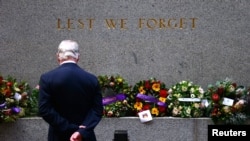Tens of thousands of Australians and New Zealanders paid tribute Tuesday at memorials and graves for war veterans and in remembrance to the price paid in conflict in more than a century of wars.
The services, known as ANZAC Day, began following Australia’s and New Zealand’s role in fighting alongside former colonial power, Britain, in the trenches of Gallipoli against the Ottoman Turkish Empire during World War I (1914-18).
Australian Foreign Minister Julie Bishop led tributes to the 11,400 Australians and New Zealanders who perished during the campaign.
World War I left an indelible mark in the Australian consciousness. More than 60,000 Australians died and 156,000 were wounded, gassed or taken prisoner during the conflict, with the fighting forces coming from a national population of fewer than five million.
Australian Ambassador to Thailand Paul Robillard, in an address at the dawn service memorial in western Kanchanaburi province, spoke of the symbolism that accompanies the memorials.
“On this the 102 anniversary of the landing at Gallipoli, let us all reflect on what the ANZAC spirit means, the spirit of service and mateship, the firm belief in democratic freedom and being prepared to make even the ultimate sacrifice to protect the rights we’ve all enjoyed,” Robilliard said.
Called again
During the World War II almost one million Australians served in the armed forces from Africa, the Middle East and Europe, and in Asia as Japan’s Imperial Forces threatened the Australian continent.
In 1942 Japan’s troops swept down the Malaysian Peninsular taking Singapore. Thousands of people were detained as prisoners of war. Many of the troops were sent to Thailand as forced labor on the infamous “Death Railway” from Thailand to Burma.
The brutal conditions in monsoon heat and rain claimed the lives of 12,600 POWs, including 2,800 Australians and more than 90,000 civilian laborers, mostly Asian, drafted into the work.
Robilliard, addressing up to 1,000 at the service in a jungle shrouded gully cut by allied POWs over 70 years ago, known as Hell Fire Pass, said the quiet atmosphere now gave pause to understand the horror endured by the POWs.
“As we stand here we can have some sense of that [horrific] experience, we can have some sense of their courage of their determination and their pain. And that sense is only heightened by the calmness, the stillness of this place now,” he said.
In Singapore, services were held at Kranji War Memorial lawn cemetery, where thousands of Australians suffered in the notorious Changi POW camp.
In Malaysia, Sabah State’s Sandakan war memorial was built on the site of the POW camp during World War II. The ceremonies mark the remembrance of the more than 2,430 Australian and British POWs and local people who died under Japan’s Imperial rule.
Sandakan was also the site of the notorious death march at war’s end in 1945 when 1,005 POWs perished from malnutrition or were murdered.
Other ANZAC Day services are to take place in the Philippines, in Myanmar, Laos and Kuala Lumpur.
More sacrifice
In Vietnam, where 60,000 Australian troops served alongside United States and allies during the Indochina conflict from 1954 to 1975, memorials were held in Hanoi and Ho Chi Minh City.
Bob Hall, a Vietnam veteran and history lecturer at the University of New South Wales, said ANZAC Day is a reminder of those lost to conflict.
“For me it’s a reminder of mates that I have lost in Vietnam. It’s not much more than that. It doesn’t tell me much historically, it tells me about the personal side of loss in war. But that’s just me,” Hall told VOA.
Martin Stuart-Fox, emeritus professor of history from Queensland University, said conflicts often called by politicians, leave the suffering to be borne by ordinary people.
“We sent people out there to fight wars wherever it is and they fought them to the best of their ability, and they were our representatives in doing so and we should honor that,” Stuart-Fox said.
The Indochina War from 1954 to 1975 claimed more than 1.45 million lives from Vietnam, Cambodia and Laos.
The Korean War of 1950 to 1953 left 36,574 U.S. troops dead, with South Korea suffering 217,000 military and one million civilian deaths, while more than 400,000 North Korean soldiers and 600,000 civilians died in the conflict.
The Australian and New Zealand memorials come against a backdrop of rising tensions on the Korean Peninsula and fears of potential conflict over North Korea’s nuclear weapons’ program.
On Tuesday, the U.N. investigator on human rights in the Democratic People's Republic of Korea (North Korea), Tomas Ojea Quintana, made an urgent appeal for the lowering of political and military tensions.
Ojea Quintana called for restoring dialogue with North Korea and other governments involved in the current hostilities, saying they “have to realize the great responsibility on their shoulders to preserve peace and stability.”










